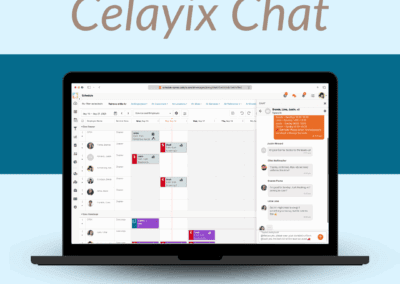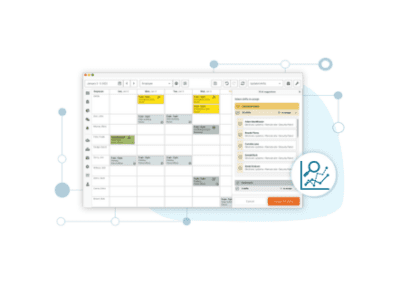In today’s dynamic work environment, fostering strong connections among employees is more crucial than ever. Whether your team operates virtually, on-site, or in a hybrid model, implementing effective team-building activities can bridge gaps, enhance collaboration, and boost overall productivity. These activities not only promote a cohesive work culture but also contribute to individual employee satisfaction and retention. By integrating thoughtfully designed team-building exercises, organizations can cultivate an environment where creativity thrives, communication flows seamlessly, and collective goals are achieved efficiently.
Benefits of Team Building Activities
Team building activities have become somewhat commonplace in many job settings. This isn’t just because it’s the trendy thing to do! Team building activities actually have a range of great benefits for everyone involved, as well as for the organization!
1 – Improved Communication
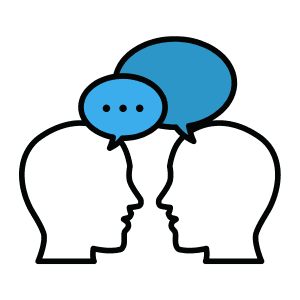
Communication is a key component to success for any business. Peer-to-peer, manager-to-employee, and interdepartmental communication are absolutely essential in order to work well as an organization. Team-building activities create opportunities for employees to engage in open dialogues, share perspectives, and understand each other’s communication styles. This enhanced interaction leads to fewer misunderstandings, more efficient workflows, and a collaborative atmosphere where ideas are freely exchanged.
2 – Increased Productivity
Improving communication creates a domino effect, and generally leads to increased productivity. Team-building exercises encourage employees to work together towards common objectives, streamline processes, and leverage each other’s strengths. This synergy results in higher efficiency and the ability to tackle challenges more effectively.
3 – Identify Leaders
As a manager or business owner, it often falls to you to identify potential leaders within your team. Whether they will head up an important project or manage a new team, it can be beneficial to identify those with great leadership qualities. Team-building scenarios often place individuals in situations where leadership qualities emerge.
Observing how team members navigate challenges, delegate tasks, and motivate peers can reveal potential leaders within the organization. Recognizing and nurturing these qualities can lead to the development of future managers and team leads.
4 – Build Confidence and Creativity
Not all, but most team-building activities encourage some form of creativity. Creative problem solving, taking initiative, and even construction games all bring out the creative side of employees who may not have a creative element to their role. This creativity is then carried through to their day-to-day duties and can lead to new, more effective processes.
Along with this creativity, employees often find a sense of confidence in team-building activities. Encouragement from their peers, learning to work well as a team and of course, the freedom to suggest ideas and solutions helps team members find their confidence as an employee.
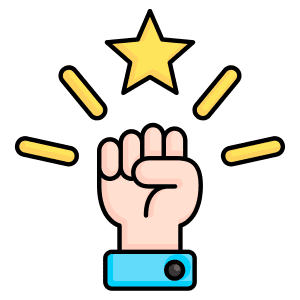
5 – Boosted Morale and Motivation
Engaging in enjoyable and meaningful activities fosters a sense of belonging and appreciation among team members. This positive environment boosts morale, leading to increased motivation and a willingness to go above and beyond in their roles. High morale is directly linked to reduced turnover rates and a more committed workforce.
6 – Strengthened Trust and Collaboration
Trust is fundamental to any team’s success. Team-building exercises that require collaboration help build trust among members. As employees work together to achieve common goals, they learn to rely on each other’s strengths and support one another, leading to a more cohesive and united team. In fact, according to TeamStage; organizations that promote collaboration and communication are 4.5 times less likely to lose their best employees.
Team Building Activities for your Team
So, enough about why you should be leveraging team-building activities for your business – let’s take a look at 10 different team building games and activities you can try! We’ve broken them down into categories below. While naturally there is overlap in their functionality, rotating between these main categories and functions will help you achieve well-rounded team-building efforts.
Getting to Know Each Other
We know that for any team to be successful, it can be helpful to understand how other people work and operate. Getting to know people on a deep level in a work setting isn’t easy. Let’s break down some team building activities that help your team members get to know each other better! These activities are often used to break the ice!
3 Truths 1 Lie
This game is easy to play and a great example of a team-building activity for in-house or remote workforces. If playing in person, give each team member four sheets of paper. If playing online, have them simply open a word doc, or maybe use a Google Form. Instruct them to write down 3 truths about themselves, and one lie.
Of course, the more believable the lie is, the better. It might help to establish some ground rules on off-limit topics in order to keep things professional. Once everyone has written their facts, go around the room and have each team member read them out in random order. Then, the team can discuss what they think might be true or false!
There’s no need to keep score or assign points here, it’s just a fun way to learn more about colleagues.
This is a great way for all team members to share some insight into who they are. While natural extroverts generally share with colleagues, introverts or new hires tend to keep to themselves. This game also brings to light certain assumptions that the team makes about certain members, which can be very interesting.
Not only do team members learn about their counterparts, but they learn about their own prejudices based on lies they assumed were true! Overall, this is a fun, casual and easy to run team building activity.
Show and Tell
99% of us have likely taken part in show and tell at some point in our lives. Unfortunately, it’s something that we generally only do when we’re much younger, while still at school! It’s not too often that we get the opportunity to show off something we’re passionate about that isn’t work related, in the workplace.
Show and tell is a great way for team members to show off a new side of their personality to their counterparts. This team building activity is something that can be done on a regular basis – monthly, quarterly or annually. Or, it can even be done weekly with just one or two team members presenting each time. Give each team member a chance to present their topic, and then allow time for team members to ask questions and open up discussion.
Similar to the above, some team members take part in show and tell on a casual basis just due to their extroverted nature. However, quieter employees often go unnoticed for their hobbies and interests outside of work, so this is a great way to level the field. Show and tell encourages a deeper connection with teammates, can lead to new-found common interests and even improves presentation skills. Win, win, win.
Improving Teamwork

Without effective teamwork, organizations simply cannot function. While some job functions do rely on individual work efforts, generally, departments need to work together, and a strong sense of team helps individuals all work towards a common goal. Here are some team building activities to help develop a sense of teamwork.
Building Block Ideas
This one generally works best with in-person teams, but can probably be altered to work for remote or mobile workforces. To begin, create a fictional problem that needs to be solved. It can be anything from a riddle to a design challenge and everything in between. The only requirement is that the scenario needs a solution.
Each team member gets a piece of paper to write a solution to the problem on. If working remotely, this can be done with a slack message that team members can reply to. Keep it simple, with a 1–2-line solution to the problem. Then, everyone passes their piece of paper to the person on their left.
They must then use the new solution in front of them to build out another solution. Optionally, before each round, more information on the problem can be provided to add new levels to the solution.
This team building activity is a great way to show the value of everyone’s contributions. Unlike traditional brainstorming sessions, this gives each team member an equal opportunity to have their say. It also ensures that all team members take each solution seriously and fully consider it. Everyone contributes and everyone is heard!
The Barter Puzzle
Another great team building activity to improve and encourage teamwork is the barter puzzle. Gather the whole team, and divide employees into groups of equal members. Provide each team with a jigsaw puzzle, and ensure that each team’s puzzle is equally difficult. Give them a set amount of time to complete each puzzle – sounds easy right?
However, there is a catch. Each team has some puzzle pieces belonging to each of the other teams in the room! The race is on for each team to complete their puzzle, by convincing other teams to give them the pieces they need! As the name suggests, bartering is the name of the game.
Teams can swap people, donate time, swap puzzle pieces or by forming alliances. The main rule is just that whatever they decide to do, they must do it as a team. This one can take some time, but it really does encourage creative teamwork. They’re solving a puzzle while also solving the problem – ultimate team bonding!
Problem Solving

In most industries, there is some element of problem-solving required for roles. Even if employees are not solving problems on a day-to-day basis – problem-solving is an essential skill. Here are some team building activities that help develop problem-solving skills.
Use What You Have
The great thing about this team building activity is that you set the challenge, and it can be done in your workspace with no extra props. Split the group up into teams of equal members. Create a task with clear instructions and a specific goal.
The challenge is totally up to you, but building tasks generally work best as you’ll see.
Next, you can either give each team the same supplies, or you can create a pile in the middle of the room for people to grab from. Set a time limit, remind them they can only use the resources provided, and encourage them to get crafty!
This is a very fun way of encouraging creative problem solving. Reducing the resources available to your team will encourage them to think outside the box!
Escape Room
Unlike the team building activity above, this one requires you to take your team outside the usual workspace. It can be great to take the team outside of the usual setting – it often leads to people letting their professional guards down! We’ve all heard of escape rooms, and most of us have likely completed one at some point.
Most cities around the U.S and Canada have a variety of options, with different themes and styles. Depending on the size of your team, you might have to split people up into groups. We recommend creating a mix of different departments and roles in the teams in order to get people working to solve problems with new people with different thought processes!
Escapes room are fun, casual, and a great ice breaker for teams outside of the workplace. Of course, they usually come with a cost. So, maybe use escape rooms as a way to get over problem-solving barriers, introduce new key team members, or just on an annual basis to keep problem solving skills in check.
Benefits the Business
While all team-building activities are great for the team, there are actually some that can directly benefit the business too! Let’s take a look at some here.
Mad Lib Mission Statement
Every company has a mission statement(s). Take your mission statement and turn it into a Mad Lib game! This is pretty easy to do – simply remove the key nouns, verbs and adjectives. Using pen and paper, a word doc if you’re working remotely, or a whiteboard to work together as a team, write the mission statement with those words replaced with a placeholder of the type of word that is missing.
Ask everyone to supply one word at a time, going between the different types of words needed. Gather enough to fill in all of the blanks, and read the statement aloud together – it’s usually pretty funny after the first round! Keep going until the team thinks they’ve filled in the blanks correctly and reveal the actual statement to see how close they got!
You can also alter this game by blindly asking for the types of words needed without telling the team you’re creating the mission statement. This might bring new ideas to light and words they might never have suggested for a mission statement. By taking the seriousness and jargon away from the idea of a mission statement, you and your team create something that is reflective of how you work, in an honest fashion.
Organizational Jenga
This particular team building idea really only works for in-person teams. Grab a Jenga game, or even better, one of those giant-sized ones! This game will be made easier if you know the general make-up of your company across different hierarchies and departments.
You’ll be using labels such as HR, Manager, Support Staff, Admin, Marketing, etc. Or whatever labels are appropriate for your organization. If 20% of your staff are managers, 20% of your block should be managers, and so on. Split the team up into groups and give them all the same number of blocks, with the same general types of blocks.
You can either get them to build any type of structure, or you give them specific instructions on what you want them to build. Give them a set time limit to do this.
Once each team has built their structure, inform them that they now must take it in turns removing one block at a time without destroying their structure – just like jenga!! If you have the time, you can allow them to complete a second round, now with the knowledge that they will be removing blocks at the end.
This activity essentially highlights how important each department and role is to the success of the organization. Often as employees, we forget that we don’t work in isolation and that we rely on others, who also rely on us.
Communication
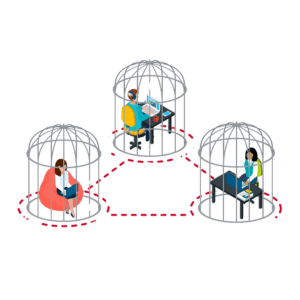
Finally, we’re going to look at some team-building activities that centre around communication. Here at Celayix, we totally understand the importance of communication in workforce management in order to be productive and efficient.
Blind Drawing
Gather your team, and break them up into pairs. We encourage you to assign pairs of people who may not often work together. Have each pair sit back-to-back, and give one a picture. Give the other person a pen and paper.
Of course, the team member with the picture must avoid showing their partner the image.
Instead, they will describe the image without using direct descriptions, while their partner tries to replicate the image. Set a time limit, and let the games begin! In theory, this could work virtually too – just with some slight modification screen sharing!
More often than not, the second image is miles away from the original. However, the pairs are forced to use creative language and clear communication to get their point across. This team building activity shows the importance of clear instructions as well as the concept of interpretation. It’s very fun to take part in, as well as spectate on!
The Perfect Square
This team building activity, only works for in-person teams. Gather the team, or split larger teams into groups of 10-15. Have them stand in a circle and pop on a blindfold. The only prop you’ll need for this one is a long piece of rope, tied together at the ends to form a loop.
Have each team member hold the rope, and leave the circle.
Instruct the team to try and form a perfect square with the rope, without removing their blindfolds of course. You can create other fun rules such as limiting some members from speaking. You could also allow them to create a plan before placing their blindfolds on, but once they do, they can’t speak again!
Once the team thinks they’ve formed their square, allow them to take off their blindfolds and admire their work. This team building activity shows the importance of effective communication as well as leadership styles. Removing the ability to see leads to alternative ways of communicating while the muting rule introduces the importance of trust. This is a quick, very fun exercise that is always successful with all teams.
Physical Team-Building Activities
Incorporating physical activities can energize the team and promote health and wellness. These activities often require teamwork and coordination.
Obstacle Course
Set up an obstacle course that teams must navigate together. This could include challenges like climbing, crawling, and balancing. Such activities build trust, improve communication skills, build camaraderie and encourage mutual support.
Virtual Team-Building Activities

With the rise of remote work, virtual team-building activities have become essential. They help maintain connections and team cohesion despite physical distances for remote teams.
Example: Virtual Trivia Night
Organize a trivia game over a video conferencing platform. Questions can range from general knowledge to fun facts about team members. This activity promotes engagement, friendly competition, and learning.
Case Study: Microsoft’s Charitable Team-Building Success with the End-Hunger Games
Case Study: Microsoft’s Charitable Team-Building Success with the End-Hunger Games
One of the most rewarding ways to bring teams closer together is through activities that combine fun, collaboration, and giving back to the community. Microsoft, a long-standing advocate of corporate social responsibility, exemplified this perfectly with a unique and philanthropic team-building experience.
Microsoft sought an activity that would strengthen bonds among their employees while aligning with their values of community support and engagement. Enter: the End-Hunger Games. This activity checks all the boxes for corporate team builfing – it was interactive, entertaining, and purpose-driven.
The event was designed to maximize engagement and teamwork. Microsoft’s team was divided into small groups that competed in various challenges, including relay races and target practice, earning points represented by non-perishable food items. The real excitement came during the grand finale, where teams used their collected food items to construct impressive structures in a friendly competition.
The result? A truckload of food donations delivered to a local food bank, making a tangible impact in their community.
This experience not only allowed Microsoft employees to bond in a meaningful way but also reinforced their commitment to social responsibility, leaving a lasting impression on their team and the beneficiaries of their generosity.
The End-Hunger Games highlights how team-building activities can go beyond the workplace, fostering both camaraderie and a sense of purpose that resonates deeply with participants.
We hope that you and your team find some joy and fun in the team-building activities shared in this post.


